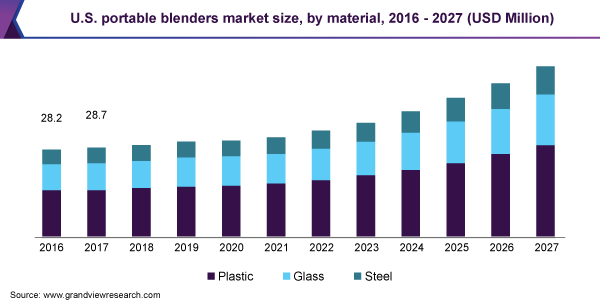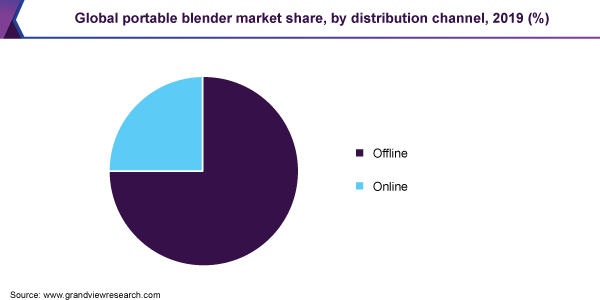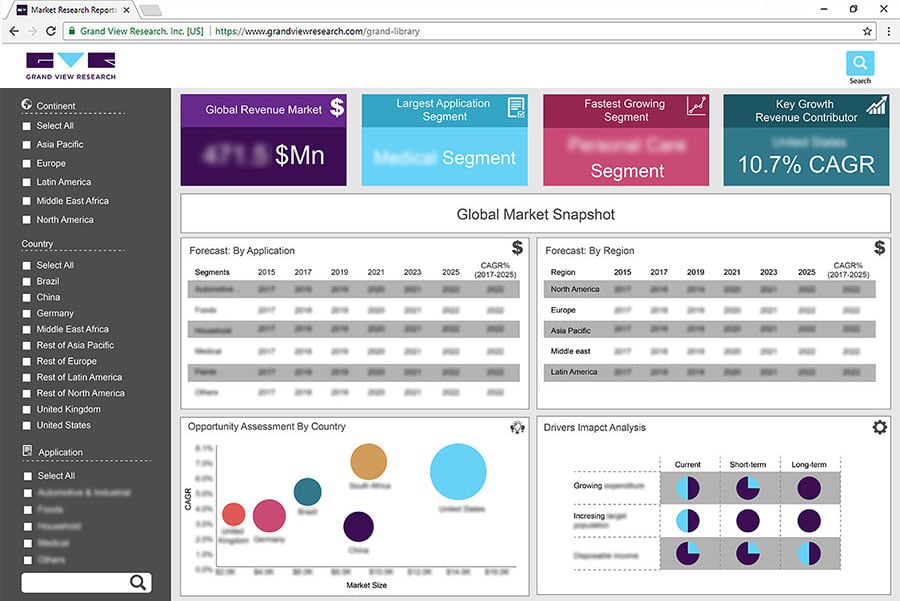- Home
- »
- Electronic & Electrical
- »
-
Portable Blenders Market Size, Industry Report, 2020-2027GVR Report cover
![Portable Blenders Market Size, Share & Trends Report]()
Portable Blenders Market Size, Share & Trends Analysis Report By Material (Plastic, Glass, Steel), By Distribution Channel (Offline, Online), By Region, And Segment Forecasts, 2020 - 2027
- Report ID: GVR-4-68038-976-0
- Number of Report Pages: 80
- Format: PDF, Horizon Databook
- Historical Range: 2016 - 2018
- Forecast Period: 2020 - 2027
- Industry: Consumer Goods
Report Overview
The global portable blenders market size was valued at USD 120.8 million in 2019 and is expected to grow at a compound annual growth rate (CAGR) of 8.1% from 2020 to 2027. The increasing popularity of healthy meals and drinks as a result of higher adoption of a healthy lifestyle among individuals, coupled with increased travel needs, has been fueling the market growth. Rapid urbanization, changing lifestyles, shifting food consumption behavior, and hectic schedules of the consumers have been boosting the sales of portable blenders over the years across the globe. With the rising demand for portable kitchen appliances, demand for portable blenders has been witnessing significant growth in the urban areas, where a large working population seeks time and effortless meals.

The increasing popularity of smoothies and shakes amongst health-conscious consumers has resulted in higher penetration of portable blenders in their lifestyle owing to hefty price tags of smoothies and juices across shops. As time-poor consumers seek out tasty, health-conscious ways to stay fueled when heading out of the house, these portable blenders emerge as a convenient option to opt for cost-effective ways of consuming healthy and customized drinks.
The presence of a large working population across countries compared to historic times has presented a wider scope for portable and convenient small kitchen appliances for easy and faster mechanism. Thus, the increasing prominence of a portable kitchen is also driving the sales of portable blenders among consumers. Moreover, limited space availability at millennial homes, particularly people living in rented houses such as bachelors are highly inclined to the adoption of portable and small kitchen appliances, is increasing demand for portable blenders.
In addition, an increasing number of dual-income households over the world have been boosting product demand. As per the survey of YouGov PLC, over 55% of the households in the U.S. were dual-income households in 2018. Similarly, according to the Modern Families Index 2019, over 75% of the households in the U.K. were dual earners. Thus, a high number of dual-income families in these countries is expected to increase product demand over the forecast years.
The higher inclination of people towards the usage of small appliances for cooking and health and wellness amidst the pandemic situation across the globe has positively impacted the demand for portable blenders. According to the NPD Group, the sale of small appliances grew by 8% for the week ending March 14, 2020. Moreover, there has been a significant increase in the sale of small kitchen appliances, such as citrus juicers, with people spending more time in the kitchen than eating out.
Material Insights
Plastic material held the largest share of 53.4% in 2019. Portable blenders made of plastic are the most convenient choice among consumers for travel purposes. This device eases the process of enjoying a healthy smoothie or drinkable weight loss supplement in a gym, during outdoor workouts, or at office desks as the product is lightweight as well as durable. Consumers’ inclination towards durability in these products owing to the risk of breaking when dropped has made plastic portable blender a highly accessible product. For instance, SharkNinja Operating LLC offers The Ninja Personal Blender, wherein the lids are made from four-sided plastic for extra durability.
Glass material is expected to witness considerable growth over the forecast period. This is attributed to the advancement of glass material in portable jars owing to its advantages, including scratch resistance, no impact on the food, perfect transparency, environment-friendly, recyclable, and non-food absorbing. Steel material has also paved its way into portable blenders owing to the high durability provided to the users.
Distribution Channel Insights
The offline distribution channel accounted for a share of 75.1% in 2019. This is attributed to the high prominence of offline channels as it facilitates the consumers to have a first-hand look at the products, which helps in the easy inspection of the quality and specifications. With the help of traditional brick and mortar stores, the brands have been able to create a unique experience for the customers. Moreover, the presence of an in-store associate helps the customers in understanding the product better, thereby making an appropriate selection. The availability of a wide range of products offered by different brands and the ability to compare the prices and product attributes are some of the factors expected to have a positive impact on segment growth.
In addition, discounted prices and budget-friendly offers provided by retailers drive more customer footfall in these stores. Moreover, the availability of different portable blender products at a cheaper rate offered by local manufacturers is likely to attract a greater number of customers to supermarkets and hypermarkets.

The online distribution channel is expected to witness the fastest growth during forecast years with a CAGR of 8.3% from 2020 to 2027. The convenience of shopping and rising penetration of online shopping portals have been fueling the growth of the online distribution channel. Major online channels include company portals and e-commerce websites. The online segment is expected to witness significant growth in the future years due to the increasing number of online shoppers who are preferring various e-commerce platforms.
In addition, the availability of a wide range of products from domestic as well as international players online is expected to boost the consumer preference for e-commerce platforms. The availability of exclusive products and their first pieces are some of the factors likely to propel the sales through company portals. For instance, in August 2018, Revablend, Inc. introduced a non-electric line of portable personal blenders and mixers through the online company portal. The product features premium food-grade quality stainless steel blades, nylon propeller, and lightweight BPA free polypropylene plastic bottle.
Regional Insights
North America held the largest share of 30.7% in 2019. Increased traction towards a healthy diet and intake of nutritious food among citizens in the region have resulted in high penetration of portable blenders. For instance, as of 2019, there were around 45 million adults in the U.S. with a gym membership. Consumers of this region are seeking for sustainable food production, healthy diets, transparency, food safety, and convenience. Considering the growing trend, many producers have started redefining products and appliances, which are catering to convenient and healthier options for health-conscious consumers.
Asia Pacific is expected to witness the fastest growth during forecast years with a CAGR of 9.0% from 2020 to 2027. China, India, Japan, South Korea, Hong Kong, Singapore, and India are the prominent markets that are likely to pose a wide growth opportunity for the product in the upcoming years. Demand is anticipated to grow due to an increase in the purchasing power of consumers, preference for healthy drinks, and a decline in consumption of sugary drinks. This is expected to boost market growth in the Asia Pacific over the forecast period.
Key Companies & Market Share Insights
The industry has been characterized by the presence of a large number of international and regional players. Players have been introducing new products in order to gain a competitive advantage in the market. Furthermore, key players are expanding their businesses in emerging markets to capture growth opportunities. Moreover, companies have been partnering with retailers to expand their consumer reach. For instance, as of January 2020, Aldi India re-released their sell-out portable blender, after shoppers purchased the gadget that was sold out in one day in 2019. The product comprises a 400ml blending cup, stainless steel blades, and a rechargeable battery. Some of the prominent players in the portable blenders market include:
-
Conair Cuisinart
-
Pop Babies
-
TOPQSC
-
Oster
-
BILACA
-
Hamilton Beach
-
Keyton
-
Little bees
-
Blufied
-
NutriBullet
-
BELLA
Portable Blenders Market Report Scope
Report Attribute
Details
Market size value in 2020
USD 123.5 million
Revenue forecast in 2027
USD 225.1 million
Growth Rate
CAGR of 8.1% from 2020 to 2027
Base year for estimation
2019
Historical data
2016 - 2018
Forecast period
2020 - 2027
Quantitative units
Revenue in USD million and CAGR from 2020 to 2027
Report coverage
Revenue forecast, company ranking, competitive landscape, growth factors, and trends
Segments covered
Material, distribution channel, region
Regional scope
North America; Europe; Asia Pacific; Central & South America; Middle East & Africa
Country scope
U.S.; Germany; U.K.; China; India; Brazil
Key companies profiled
Conair Cuisinart; Pop Babies; TOPQSC; Oster; BILACA; Hamilton Beach; Keyton; Little bees; Blufied; NutriBullet; BELLA
Customization scope
Free report customization (equivalent up to 8 analysts working days) with purchase. Addition or alteration to country, regional & segment scope.
Pricing and purchase options
Avail customized purchase options to meet your exact research needs. Explore purchase options
Segments Covered in the ReportThis report forecasts revenue growth at the global, regional, and country levels and provides an analysis of the latest industry trends and opportunities in each of the sub-segments from 2016 to 2027. For the purpose of this study, Grand View Research has segmented the global portable blenders market report on the basis of material, distribution channel, and region:
-
Material Outlook (Revenue, USD Million, 2016 - 2027)
-
Plastic
-
Glass
-
Steel
-
-
Distribution Channel Outlook (Revenue, USD Million, 2016 - 2027)
-
Offline
-
Online
-
-
Regional Outlook (Revenue, USD Million, 2016 - 2027)
-
North America
-
The U.S.
-
-
Europe
-
Germany
-
The U.K.
-
-
Asia Pacific
-
China
-
India
-
-
Central & South America
-
Brazil
-
-
Middle East & Africa
-
Frequently Asked Questions About This Report
b. The global portable blenders market size was estimated at USD 120.8 million in 2019 and is expected to reach USD 123.5 million in 2020.
b. The global portable blenders market is expected to grow at a compound annual growth rate of 8.1% from 2020 to 2027 to reach USD 225.1 million by 2027.
b. North America dominated the portable blenders market with a share of 30.7% in 2019. This is attributable to higher traction towards a healthy diet and the intake of nutritious food among citizens in the region have resulted in high penetration of portable blenders.
b. Some key players operating in the portable blenders market include Conair Cuisinart, Pop Babies, TOPQSC, Oster, BILACA, Hamilton Beach, Keyton, Little bees, Blufied, NutriBullet, and BELLA.
b. Key factors that are driving the market growth include increasing the popularity of healthy meals and drinks as a result of higher adoption of a healthy lifestyle among individuals coupled with increased travel needs has been driving the market growth.
Share this report with your colleague or friend.
![gvr icn]()
NEED A CUSTOM REPORT?
We can customize every report - free of charge - including purchasing stand-alone sections or country-level reports, as well as offer affordable discounts for start-ups & universities. Contact us now
![Certified Icon]()
We are GDPR and CCPA compliant! Your transaction & personal information is safe and secure. For more details, please read our privacy policy.
We are committed towards customer satisfaction, and quality service.
"The quality of research they have done for us has been excellent."





